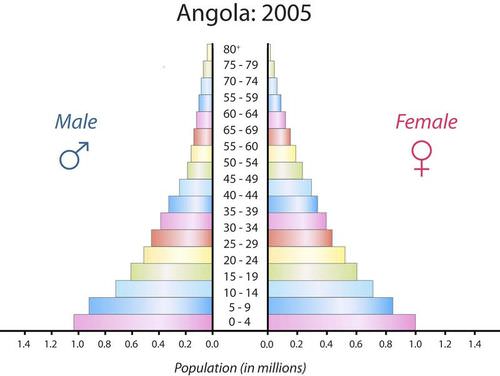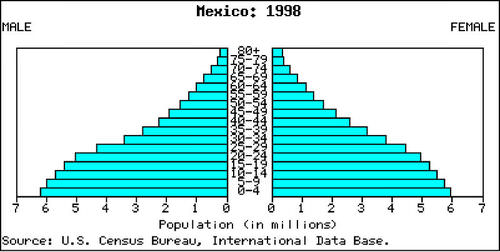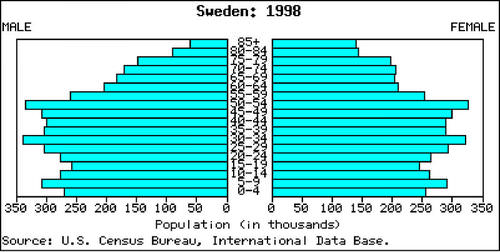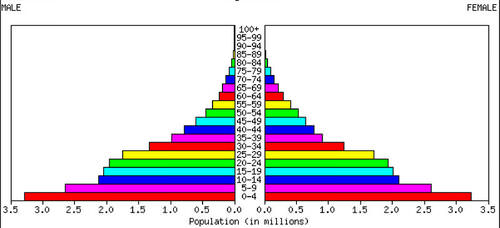6.15: Recent and Future Population Growth
- Page ID
- 12142
\( \newcommand{\vecs}[1]{\overset { \scriptstyle \rightharpoonup} {\mathbf{#1}} } \)
\( \newcommand{\vecd}[1]{\overset{-\!-\!\rightharpoonup}{\vphantom{a}\smash {#1}}} \)
\( \newcommand{\dsum}{\displaystyle\sum\limits} \)
\( \newcommand{\dint}{\displaystyle\int\limits} \)
\( \newcommand{\dlim}{\displaystyle\lim\limits} \)
\( \newcommand{\id}{\mathrm{id}}\) \( \newcommand{\Span}{\mathrm{span}}\)
( \newcommand{\kernel}{\mathrm{null}\,}\) \( \newcommand{\range}{\mathrm{range}\,}\)
\( \newcommand{\RealPart}{\mathrm{Re}}\) \( \newcommand{\ImaginaryPart}{\mathrm{Im}}\)
\( \newcommand{\Argument}{\mathrm{Arg}}\) \( \newcommand{\norm}[1]{\| #1 \|}\)
\( \newcommand{\inner}[2]{\langle #1, #2 \rangle}\)
\( \newcommand{\Span}{\mathrm{span}}\)
\( \newcommand{\id}{\mathrm{id}}\)
\( \newcommand{\Span}{\mathrm{span}}\)
\( \newcommand{\kernel}{\mathrm{null}\,}\)
\( \newcommand{\range}{\mathrm{range}\,}\)
\( \newcommand{\RealPart}{\mathrm{Re}}\)
\( \newcommand{\ImaginaryPart}{\mathrm{Im}}\)
\( \newcommand{\Argument}{\mathrm{Arg}}\)
\( \newcommand{\norm}[1]{\| #1 \|}\)
\( \newcommand{\inner}[2]{\langle #1, #2 \rangle}\)
\( \newcommand{\Span}{\mathrm{span}}\) \( \newcommand{\AA}{\unicode[.8,0]{x212B}}\)
\( \newcommand{\vectorA}[1]{\vec{#1}} % arrow\)
\( \newcommand{\vectorAt}[1]{\vec{\text{#1}}} % arrow\)
\( \newcommand{\vectorB}[1]{\overset { \scriptstyle \rightharpoonup} {\mathbf{#1}} } \)
\( \newcommand{\vectorC}[1]{\textbf{#1}} \)
\( \newcommand{\vectorD}[1]{\overrightarrow{#1}} \)
\( \newcommand{\vectorDt}[1]{\overrightarrow{\text{#1}}} \)
\( \newcommand{\vectE}[1]{\overset{-\!-\!\rightharpoonup}{\vphantom{a}\smash{\mathbf {#1}}}} \)
\( \newcommand{\vecs}[1]{\overset { \scriptstyle \rightharpoonup} {\mathbf{#1}} } \)
\( \newcommand{\vecd}[1]{\overset{-\!-\!\rightharpoonup}{\vphantom{a}\smash {#1}}} \)
\(\newcommand{\avec}{\mathbf a}\) \(\newcommand{\bvec}{\mathbf b}\) \(\newcommand{\cvec}{\mathbf c}\) \(\newcommand{\dvec}{\mathbf d}\) \(\newcommand{\dtil}{\widetilde{\mathbf d}}\) \(\newcommand{\evec}{\mathbf e}\) \(\newcommand{\fvec}{\mathbf f}\) \(\newcommand{\nvec}{\mathbf n}\) \(\newcommand{\pvec}{\mathbf p}\) \(\newcommand{\qvec}{\mathbf q}\) \(\newcommand{\svec}{\mathbf s}\) \(\newcommand{\tvec}{\mathbf t}\) \(\newcommand{\uvec}{\mathbf u}\) \(\newcommand{\vvec}{\mathbf v}\) \(\newcommand{\wvec}{\mathbf w}\) \(\newcommand{\xvec}{\mathbf x}\) \(\newcommand{\yvec}{\mathbf y}\) \(\newcommand{\zvec}{\mathbf z}\) \(\newcommand{\rvec}{\mathbf r}\) \(\newcommand{\mvec}{\mathbf m}\) \(\newcommand{\zerovec}{\mathbf 0}\) \(\newcommand{\onevec}{\mathbf 1}\) \(\newcommand{\real}{\mathbb R}\) \(\newcommand{\twovec}[2]{\left[\begin{array}{r}#1 \\ #2 \end{array}\right]}\) \(\newcommand{\ctwovec}[2]{\left[\begin{array}{c}#1 \\ #2 \end{array}\right]}\) \(\newcommand{\threevec}[3]{\left[\begin{array}{r}#1 \\ #2 \\ #3 \end{array}\right]}\) \(\newcommand{\cthreevec}[3]{\left[\begin{array}{c}#1 \\ #2 \\ #3 \end{array}\right]}\) \(\newcommand{\fourvec}[4]{\left[\begin{array}{r}#1 \\ #2 \\ #3 \\ #4 \end{array}\right]}\) \(\newcommand{\cfourvec}[4]{\left[\begin{array}{c}#1 \\ #2 \\ #3 \\ #4 \end{array}\right]}\) \(\newcommand{\fivevec}[5]{\left[\begin{array}{r}#1 \\ #2 \\ #3 \\ #4 \\ #5 \\ \end{array}\right]}\) \(\newcommand{\cfivevec}[5]{\left[\begin{array}{c}#1 \\ #2 \\ #3 \\ #4 \\ #5 \\ \end{array}\right]}\) \(\newcommand{\mattwo}[4]{\left[\begin{array}{rr}#1 \amp #2 \\ #3 \amp #4 \\ \end{array}\right]}\) \(\newcommand{\laspan}[1]{\text{Span}\{#1\}}\) \(\newcommand{\bcal}{\cal B}\) \(\newcommand{\ccal}{\cal C}\) \(\newcommand{\scal}{\cal S}\) \(\newcommand{\wcal}{\cal W}\) \(\newcommand{\ecal}{\cal E}\) \(\newcommand{\coords}[2]{\left\{#1\right\}_{#2}}\) \(\newcommand{\gray}[1]{\color{gray}{#1}}\) \(\newcommand{\lgray}[1]{\color{lightgray}{#1}}\) \(\newcommand{\rank}{\operatorname{rank}}\) \(\newcommand{\row}{\text{Row}}\) \(\newcommand{\col}{\text{Col}}\) \(\renewcommand{\row}{\text{Row}}\) \(\newcommand{\nul}{\text{Nul}}\) \(\newcommand{\var}{\text{Var}}\) \(\newcommand{\corr}{\text{corr}}\) \(\newcommand{\len}[1]{\left|#1\right|}\) \(\newcommand{\bbar}{\overline{\bvec}}\) \(\newcommand{\bhat}{\widehat{\bvec}}\) \(\newcommand{\bperp}{\bvec^\perp}\) \(\newcommand{\xhat}{\widehat{\xvec}}\) \(\newcommand{\vhat}{\widehat{\vvec}}\) \(\newcommand{\uhat}{\widehat{\uvec}}\) \(\newcommand{\what}{\widehat{\wvec}}\) \(\newcommand{\Sighat}{\widehat{\Sigma}}\) \(\newcommand{\lt}{<}\) \(\newcommand{\gt}{>}\) \(\newcommand{\amp}{&}\) \(\definecolor{fillinmathshade}{gray}{0.9}\)
Should the population of the planet by characterized by individual country, or as one general population?
How many people is too many? Is there a limit? Is there a carrying capacity for humans? These are important questions that do not have an easy answer. But as our population continues to grow, these questions and others should be discussed.
Recent Population Growth
At one time, scientists predicted that all human populations would pass through the same demographic transition as Europe and North America. Now, they are not so sure. Death rates have fallen throughout the world. No country today remains in Stage 1 of the transition. However, birth rates are still high in many poor countries. These populations seem to be stuck in Stage 2. An example is the African country of Angola. Its population pyramid for 2005 is shown in Figure below. The wide base of the pyramid base reflects the high birth rate of this population.
 Angola’s population pyramid is typical of Stage 2 of the demographic transition.
Angola’s population pyramid is typical of Stage 2 of the demographic transition.Many other countries have shifted to Stage 3 of the transition. Birth rates have started to fall. As a result, population growth is slowing. An example is Mexico. Its population pyramid for 1998 is shown in Figure below. It reflects a recent fall in the birth rate.

Mexico’s 1998 population pyramid is typical of Stage 3 population. How can you tell that the birth rate has started to fall?
Most developed nations have entered Stage 4. Sweden is an example (see Figure below). The birth rate has been low for many years in Sweden. Therefore, the rate of population growth is near zero.
 Sweden’s 1998 population pyramid shows a population in Stage 4.
Sweden’s 1998 population pyramid shows a population in Stage 4.In some countries, birth rates have fallen even lower than death rates. As result, their population growth rates are negative. In other words, the populations are shrinking in size. These populations have top-heavy population pyramids, like the one for Italy shown in Figure below. This is a new stage of the demographic transition, referred to as Stage 5. You might think that a negative growth rate would be a good thing. In fact, it may cause problems. For example, growth-dependent industries decline. Supporting the large aging population is also a burden for the shrinking younger population of workers.
 This 1998 population pyramid for Italy represents a Stage 5 population.
This 1998 population pyramid for Italy represents a Stage 5 population.Future Population Growth
During the month of October 2011, the world's population surpassed 7 billion people. It took just 12 years for the population to increase by a billion people. At this rate, there may be well over 9 billion people by 2050, and easily 10 billion people by 2100. This raises many questions for both people and the planet.
The human population is now growing by more than 200,000 people a day. The human population may well be close to its carrying capacity. It has already harmed the environment. An even larger human population may cause severe environmental problems. This could lead to outbreaks of disease, starvation, and global conflict. There are three potential solutions:
- Use technology to make better use of resources to support more people.
- Change behaviors to reduce human numbers and how much humans consume.
- Distribute resources more fairly among all the world’s people.
Which solution would you choose?
"If growth continued at this rate...by 2600 we would all be standing literally shoulder to shoulder" - Steven Hawking
Census Update: What the World Will Look like in 2050
According to the U.S. Census Bureau, in 2050, there will be 9.4 billion people:
- India will be the most populous nation, surpassing China sometime around 2025.
- The U.S. will remain the third most populous nation, with a population of 423 million (up from 308 million in 2010).
- Declining birth rates in Japan and Russia will cause them to fall from their current positions as the 9th and 10th most populous nations, respectively, to 16th and 17th.
- Nigeria will have a population of 402 million, up from 166 million people.
- Ethiopia's population will likely triple, from 91 million to 278 million, making the East African nation one of the top 10 most populous countries in the world.
So what does all this mean?
- The African continent is expected to experience significant population growth in the coming decades, which could compound existing food supply problems in some African nations.
- Immigration and differing birth rates among races will change the ethnic composition of the U.S.
- Population booms in Africa and India, the decline of Russia, and the expected plateau of China will all change the makeup of the estimated 9.4 billion people who will call Earth home in 2050.
Summary
- Other countries have completed similar demographic transitions. However, some countries seem stalled at early stages. They have high birth rates and rapidly growing populations.
- The total human population may have to stop growing eventually. Even if we reduce our use of resources and distribute them more fairly, at some point the carrying capacity will be reached.
Review
1. Why was a fifth stage added to the demographic transition model? Describe a population at this stage.
2. Which stage of the demographic transition is represented by the population pyramid in the Figure below? Why?

3. Evaluate how well the original demographic transition model represents human populations today.
4. What is the human population problem? What are some potential solutions? Which solution do you think is best?
| Image | Reference | Attributions |
 |
[Figure 1] | Credit: ARENA Creative, 2014 Source: www.shutterstock.com License: Used under license from Shutterstock.com |
 |
[Figure 2] | Credit: Hana Zavadska, based on data from the U.S. Census Bureau Source: CK-12 Foundation License: CC BY-NC 3.0 |
 |
[Figure 3] | Credit: U.S. Census Bureau Source: www.census.gov/ipc/www/idb/country.php License: Public Domain |
 |
[Figure 4] | Credit: U.S. Census Bureau Source: www.census.gov/ipc/www/idb/country.php License: Public Domain |
 |
[Figure 5] | Credit: U.S. Census Bureau Source: www.census.gov/ipc/www/idb/country.php License: Public Domain |
 |
[Figure 6] | Credit: U.S. Census Bureau Source: www.census.gov/ipc/www/idb/country.php License: Public Domain |

